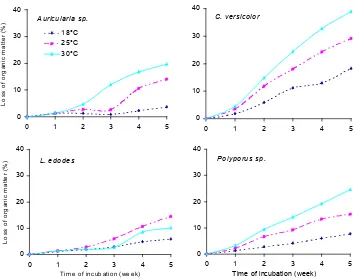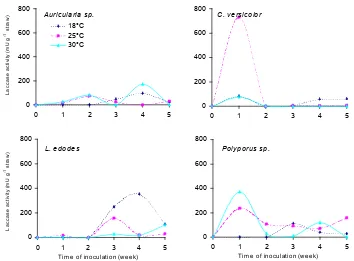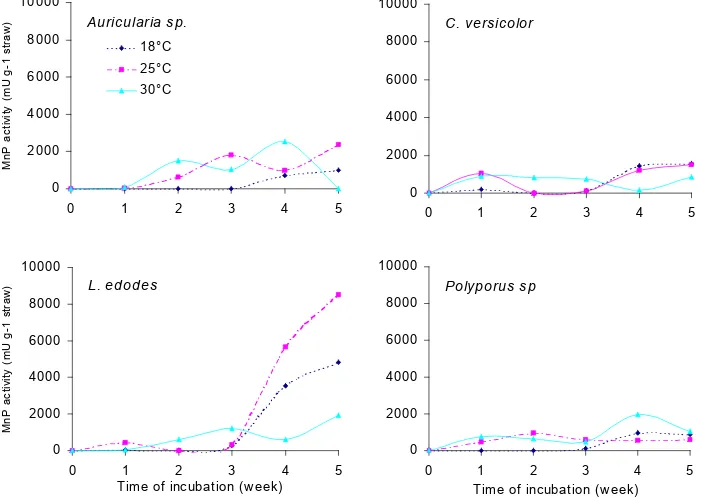Deutscher Tropentag - Bonn, 9-11 October 2001
Conference on International Agricultural Research forDevelopment
Tropical wood-decaying fungi as a means of conversion of agricultural plant residues: Influence of the incubation temperature on the activities of ligninolytic enzymes
Idat Galih Permanaa, Carsten in der Wiescheb, Udo ter Meulenc, Gerhard Flachowskyd and Frantisek Zadrazilb
a Faculty of Animal Science, Bogor Agricultural University, Jl. Rasamala-Darmaga, Bogor, Indonesia. email: [email protected]
b Institute of Plant Nutrition and Soil Science, Federal Agricultural Research Center, Braunschweig, Germany.
c Institute of Animal Physiology and Animal Nutrition, Department of Tropical Animal Nutrition, Georg-August-University, Göttingen, Germany.
d Institute of Animal Nutrition, Federal Agricultural Research Center, Braunschweig, Germany.
Abstract
The digestibility of agricultural plant residues in the rumen of domestic animals is restricted by the lignin content of the material. Selective delignification using
ligninolytic microorganisms in a solid state fermentation process may help to overcome this problem. The aim of this work was to determine the influence of the incubation temperature on the production of extracellular ligninolytic enzymes and the degradation of lignocellulose by selected tropical fungi. Four wood-inhabiting fungi, Auricularia
sp., Coriolus versicolor, Lentinus edodes and Polyporus sp., were grown on wheat straw for five weeks at 18°C, 25°C or 30°C, respectively. The activities of extracellular
ligninolytic enzymes (laccases and manganese peroxidases) were assessed weekly. In addition the substrates were analysed with regard to the in vitro digestibility, the loss of organic matter and lignin. Generally higher incubation temperature enhanced the colonization of the straw substrate by the fungal mycelium and the increase of
enzymatic activities. Moreover the highest enzyme levels were usually found at 30°C. Only L. edodes displayed highest enzyme activities at 18°C or 25°C. Loss of organic matter and loss of lignin were highest at 30°C, with the exception of L. edodes (25°C temperature optimum). C. versicolor degraded more lignin compared to the other fungi tested (69% of initial after 5 weeks). High degradation of lignin and in vitro digestibility along with relatively low degradation of other straw components was performed by
Auricularia sp. and L. edodes at 25°C, which makes these fungi seem promising with regard to selective delignification of plant waste materials.
Introduction
of these methods is the splitting of the cellulose-lignin complex by extraction or decomposition of lignin.
Lignin is characterized by high resistance to microbial decay. However, a range wood inhabiting fungi, so called white-rot fungi, are able to degrade lignin. They produce extracellular ligninolytic enzymes, mainly laccases (phenol oxidases) and manganeses peroxidases (MnP) and lignin peroxidases (Tien and Kirk 1984). The main constraints in optimizing biological upgrading of plant residues into feed are the identification of appropriate fungal species and the elucidation of factors controlling selective
delignification of lignocellulosics. One of the most important factors in this process is the incubation temperature (Zadrazil, 1985).
The aim of this work was to determine the influence of incubation temperature on the production of extracellular ligninolytic enzymes and on the degradation of
lignocellulose by selected tropical fungi, and to study the relationship between the lignin degradation and the in vitro digestibility of the straw.
Materials and Methods
Microorganisms
Four tropical wood-decaying fungi, Auricularia sp., Coriolus versicolor, Lentinus edodes and Polyporus sp. were tested. The fungi were grown on malt extract agar (1.4% malt extract, 1.5% agar) at 25°C for 7 days. Mycelium-agar plugs of 8 mm in diameter (cut along a uniform circumference) from the plates were used as inocula.
Substrate and incubation conditions
Milled wheat straw (25 g, particle size < 2 mm) in 500 ml conical flasks was moistened with 75 ml deionized water and autoclaved at 121°C for 30 min. After cooling, the flasks were inoculated with two mycelium-agar plugs each and incubated at 18°C, 25°C and 30°C in humid air for up to 5 weeks. All treatments were done in triplicate.
Determination of organic matter loss, lignin and in vitro digestibility
The loss of organic matter was calculated from the dry weight of the samples at the beginning and the end of incubation.
Lignin was analysed using hydrolysis method with H2SO4 and HCl (Halse, 1926). The in vitro digestibility was determined using the two-step method according to Tilley and Terry (1968).
Enzyme activity measurements
The extraction of straw with sodium acetate buffer (160 mM, pH 5.0) was done according to Lang et al. (1997).
Laccase activity was measured according to a modified method of Niku-Paavola et al. (1990) by monitoring the oxidation of ABTS (2,2’-azinobis-3-ethylbenzothiazoline-6-sulfonic acid, diammonium salt). Mn-peroxidase (MnP) activities were assayed according to Volc and Eriksson (1988). MBTH (3-methyl-2-benzothiazolinone
hydrazone) and DMAB (3-methylaminobenzoic acid) were oxidatively coupled by the action of the enzyme in the presence of H2O2 and manganese to give purple indamine
dye product.
is defined as catalyzing the production of one micromole of green or purple dye per milliliter per minute. All measurements were done in quadruplicate.
Results and Discussion
Loss of organic matter
C. versicolor degraded the straw substrate more efficiently than the other fungi tested. During 5 weeks of fermentation at 30°C, C. versicolor caused a loss of 40% of organic matter (Figure 1). Polyporus sp. was second with regard to degradation of organic matter. Degradation by Auricularia sp.and L. edodes was relatively slower, especially at lower temperature. In general the straw substrate was degraded faster at higher temperature. Only L. edodes was most efficient at medium incubation temperature of 25°C.
Figure 1. Influence of the incubation temperature on the loss of organic matter during solid-state fermentation of wheat straw with Auricularia sp.,
Coriolus versicolor, Lentinus edodes and Polyporus sp.
Loss of lignin and increase of in vitro digestibility
Lignin decomposition started earlier at 30°C compared to incubation at 25°C or 18°C (results not shown). Because of this at the end of experiment the loss of lignin was generally highest in the cultures incubated at 30°C (Table 1). Only L. edodes was most efficient at 25°C, corresponding to the loss of organic matter loss (Figure 1). Within 5 weeks of incubation C. versicolor degraded more lignin than the other fungi tested (70% of initial at 30°C). L. edodes displayed the lowest activity with regard to lignin
degradation (Table 1).
Auricu la ria sp.
0
Tim e of incubation (week)
L
The in vitro digestibility of the straw substrate was generally increased by the fungal treatment. The in vitro dry matter digestibility of wheat straw without treatment was only 45%. After 5 weeks of incubation with the fungi, the digestibility was increased to maximum 64% in substrate incubated with Polyporus sp. at 30°C.
The loss of lignin was not significantly correlated with the increase in vitro digestibility (R2=0.363). For example the lignin loss in cultures of L. edodes was lower than in cultures of C. versicolor and Polyporus sp., while the change of in vitro digestibility was relatively the same.
Table 1. Loss of lignin and in vitro dry matter digestibility (IVDMD) of wheat straw after 5 weeks of incubation with Auricularia sp., Coriolus versicolor, Lentinus edodes
and Polyporus sp. at different temperatures.
Parameters Fungi
Incubation
temperature Loss of lignin (%)
IVDMD (%)
18°C 9.9 44.6
Auricularia sp. 25°C 40.5 63.2
30°C 49.2 53.1
18°C 35.2 49.8
Coriolus versicolor 25°C 56.7 57.1
30°C 68.9 50.4
18°C 11.4 42.2
Lentinus edodes 25°C 39.9 56.5
30°C 17.9 62.3
18°C 25.4 49.9
Polyporus sp. 25°C 48.9 59.8
30°C 59.6 63.6
Figure 2. Influence of the incubation temperature on the activity of laccase in the straw substrate during solid-state fermentation with Auricularia sp., Coriolus versicolor, Lentinus edodes and Polyporus sp.
Laccase activity
The highest laccase activity was measured in the was highest substrate inoculated with
C. versicolor and incubated at 25°C (Figure 2). The activity of laccase peaked in the first week of incubation and then decreased to a relatively low level. At 30°C the activity was significantly lower. In the substrates inoculated with Polyporus sp. or
Auricularia sp. highest laccase activities were determined at 30°C (Figure 2). In
contrast, in the substrate inoculated with L. edodes laccase activity was highest at 18°C, but very low at 30°C.
In the substrates inoculated with C. versicolor and Polyporus sp. the laccase activity peaked earlier than Auricularia sp. and L. edodes cultures, probably it is correlated with the growth of the fungi.
Mangan peroxidase (MnP) activity
MnP activities were higher than laccase activities for all fungi. In substrate inoculated with L. edodes MnP activity was significantly higher than in the other substrates (Figure 3). The highest MnP activity was found in the substrate incubated at 25°C, with a strong increase after three weeks of incubation. C. versicolor and Polyporus sp. produced MnP at a relatively constant level during the incubation period.
Figure 3. Influence of the incubation temperature on the activity of manganese peroxidase in the straw substrate during solid-state fermentation with Auricularia sp.,
Coriolus versicolor, Lentinus edodes and Polyporus sp.
Conclusions
The degradation of organic matter and lignin by the four tropical fungi tested was significantly influenced by the temperature of incubation. Lignin degradation was most effective at 30°C for Auricularia sp., C. versicolor and Polyporus sp., and at 25°C for L. edodes. The activities of laccases and manganese peroxidases were correlated with the loss of lignin and in vitro digestibility.
Auricularia sp.
Time of incubation (w eek)
Mn
References
Halse, O.M., 1926. Determination of cellulose and wood fibre in paper. Papier Journalen. 10:121-126.
Lang, E., G. Eller, F. Zadrazil, 1997. Lignocellulose decomposition and production of ligninolytic enzymes during interaction of white rot fungi with soil
microorganisms. Microb.Ecol. 34:1-19.
Niku-Paavola, M.L., L. Raska, M. Itävaara, 1990. Detection of white rot fungi by a non-toxic strain. Mycol.Res. 94:27-31.
Tilley, J.M.A. and R.A. Terry. 1963. A two stage technique for in vitro digestion of forage crops. J. Br. Grassl. Soc. 18:104-111.
Tien M. and T. K. Kirk, 1984., Lignin degradading enzyme from Phanerochaeta chrysisporium. Meth. Enzymol. 161B:238-249.
Volc, J. and K.E. Eriksson, 1988. Pyranosa 2-oxidase from Phanerochaete chrysosporium. Meth. Enzymol. 161B:316-322.


